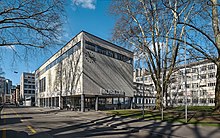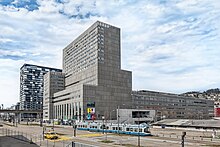Museum of Design Zurich
The Museum für Gestaltung Zürich is the leading Swiss museum for design and visual communication . The museum reaches a wide audience at two locations in Zurich - on the exhibition street and in the Toni area - as well as internationally through its traveling exhibitions. The exhibition program covers a wide range of topics and monographic positions from the areas of industrial and product design , graphics , typography , photography , posters , film , furniture , fashion , jewelry , applied arts , architecture and scenography . The four collections of the museum - design, graphics, applied arts and posters - are of international importance and with over 500,000 objects, they are rich in milestones in aesthetic and technical development.
In the heart of Zurich, in the renovated and reopened main building on Exhibition Street in 2018, the museum presents the treasures of its collection and shows exhibitions on changing themes. The listed building from 1933 is considered one of the outstanding examples of modern Swiss architecture . The museum includes the “Swiss Design Lounge”, a meeting place where you can linger and try out outstanding Swiss design, a spacious educational studio and the museum's own café and adjoining park with a pond.
In the dynamic Zurich West quarter, the museum has its second location, the Toni area. The former largest yoghurt factory in Europe is also the campus of the Zurich University of the Arts ZHdK . With changing exhibitions, the museum builds a bridge to teaching and research, shows projects that are open to experimentation and takes a position on current debates in design. The Toni area also houses the museum's collection archive with over 500,000 objects, which can be visited daily on guided tours.
History, architecture, locations
The Museum of Design Zurich emerged from the Zurich City Museum of Applied Arts, founded in 1875 . In 1933 the museum and the School of Applied Arts , which had existed since 1878 , today the Zurich University of the Arts (ZHdK) , moved into the now listed building of Adolf Steger and Karl Egender on Exhibition Street . The museum's design, applied arts, poster and graphic collections were spread across various locations in the Canton of Zurich. The Museum Bellerive on Lake Zurich, which was established in 1968, housed its collection of handicrafts and in temporary exhibitions - until the building was returned to the City of Zurich in February 2017 - the interface between art, handicrafts and design was the theme. In 2014, with the opening of the site in the Toni-Areal in Zurich-West, which was converted by EM2N Architects , the museum celebrated a milestone in its history: after many years of commitment, it was possible to unite all four collections under one roof. At the same time, the museum closed the exhibition at its historical location on the exhibition street for the purpose of extensive renovation. Reopened in March 2018, the museum in its main building is now also presenting the treasures of its collection to the public for the first time in permanent exhibitions in addition to temporary exhibitions.
Exhibitions
Most of the exhibitions are in-house productions, some of which arise from dialogue with the museum's collections or from research projects. The Museum für Gestaltung Zürich shows five to seven temporary exhibitions as well as smaller stagings and interventions at its two locations "Exhibition Street" and "Toni Areal". In the mostly interdisciplinary exhibitions, historical phenomena, contemporary tendencies and innovative approaches are presented scientifically for a broad public as well as for a specialist audience.
Scenography and visual communication
The Museum für Gestaltung Zürich works with established young scenographers , architects and visual designers who switch from project to project in the staging of the themes and the conception of visual communication . This approach leads to constantly changing exhibition and poster designs, which meet the demands of experimental curiosity with high design quality and are regularly given awards.
Mediation & events
The exhibitions at the Museum für Gestaltung Zürich are accompanied by guided tours, symposia , panel discussions , talks, lectures, film and theater productions, performances and concerts. A diverse range of educational museum offers is being developed for schools, children and adults, specifically for each exhibition.
Collections
The four collections of the museum arose from the collection of models created by the Kunstgewerbemuseum Zurich for teaching purposes. Today they are of international importance . Objects from the collections can be found in international research projects and exhibitions and are used within the Zurich University of the Arts (ZHdK) to study design solutions, materials, techniques and styles. The objects in the collections are also made available online on an ongoing basis.
Poster collection
The poster collection is one of the most extensive and important archives of its kind in the world. Over 350,000 posters, 120,000 of which have been indexed and inventoried, document Swiss and international poster history from its beginnings in the mid- 19th century to the present day. The collection includes political, cultural and commercial posters. The geographical focus, based on the history of design, is Switzerland, Europe, Japan, Cuba, the former Soviet Union and the USA. The collection is continuously expanded in dialogue with contemporary production and in recognition of historical achievements. Their diversity in historical, thematic and geographical terms enables both a Tour d'Horizon of poster art and a look into a visual archive of the everyday world. In addition to the primary issues of graphics and typography, the poster collection also focuses on a socio-political understanding of design, as the aesthetic and social processes of the respective time are particularly reflected in the poster.
Design collection
The design collection focuses on serially manufactured products of the 20th century and the present, as well as the ideas and processes that are expressed in them. The focus is on a comprehensive presentation of Swiss design, which is confronted with reference examples of international origin. Objects by well-known designers as well as anonymously conceived everyday design are collected. The collection, which now comprises more than 10,000 products and around 20,000 packaging, contains serial items down to the smallest series, supplemented by prototypes and models. In addition to purchases and donations, the design collection also includes permanent loans from the Swiss Confederation in the field of product design, a division that has been funded by the Federal Office of Culture since 1989. Parallel to the collection of objects, an archive for Swiss design is being set up to serve scientific research: Concepts , project studies, design drawings, instructions for use , patent specifications , advertising material , source texts and parts of atelier, company and association archives form the fund of documentation that goes far beyond the Object.
Graphic collection
The graphic collection, which has existed since the museum was founded, is unique in Switzerland in terms of its diversity and its current focus on European graphic design. In this area, it documents the aesthetic, technical and cultural change in everyday life from Gutenberg to the present day. Originally set up as an international model collection, the graphics collection includes almost all graphic disciplines that were important for teaching at the former arts and crafts school. The core initially consisted of drawings, prints and illustrated books as well as textbooks from the 15th to 20th centuries. This was followed by press releases, Ostasiatica as well as artist books, photography and commercial graphics. Today the collecting activity is concentrated on Switzerland and Europe. The focus is on advertising and information graphics, font , typography and book design. The collection is being further developed with current work by innovative graphic designers, advertising agencies, the estates of important designers and examples of corporate design from major companies.
Applied arts collection
The arts and crafts collection, which comprises over 15,000 objects, is the oldest collection of the Museum für Gestaltung Zürich, along with the graphic collection, and one of the most important collections of international arts and crafts in Switzerland. Once created as a collection of models for training, trade and industry, the focus of the collection is on the 19th and 20th centuries. Individual areas such as Coptic and old Peruvian textiles reach far into the past, others into the present. The diverse profile follows the artistic processing of glass, ceramics, metal, wood and textiles and is geographically concentrated mainly on Europe. Top-class examples from the USA and Japan can be found in the field of tapestries and textile sculptures. The Art Nouveau department with groups of works by William Morris , Emile Gallé , René Lalique , Hermann Obrist and Henry van de Velde enjoys an international reputation. The highlights include a unique puppet collection by artists of the 20th century such as Sophie Taeuber-Arp and an important collection of musical instruments of around 250 historical objects.
Research and services
The collections are continuously processed and researched in collaboration with the Zurich University of the Arts ZHdK and other universities in order to relate them to an openness to transdisciplinary projects from a current perspective. In addition to indexing, documentation and conservation, services such as research, expert reports and reproductions are offered.
Publications
The Museum für Gestaltung Zürich issues publications itself or in collaboration with renowned publishers, which function as an essential part of the exhibition program. In addition to thematic series such as the “Design Collection” or the “Poster Collection”, this also includes anthologies on classics from design history or current topics and monographs on pioneers in theory and practice. Due to the way they are designed and elaborated, the publications of the Museum für Gestaltung Zürich themselves make a contribution to design history, which is manifested in the prizes and awards that are often received.
literature
- Claude Lichtenstein: University of Design and Art Zurich. Museum of Design Zurich. ( Swiss Art Guide , No. 777, Series 78). Ed. Society for Swiss Art History GSK. Bern 2005, ISBN 978-3-85782-777-8 .
Web links
- Website of the Museum of Design Zurich
- The collections online
- Website of the Zurich University of the Arts ZHdK
Individual evidence
- ↑ Exhibition Street | Museum of Design Zurich. Retrieved on September 19, 2018 (German).
- ↑ Toni Areal | Museum of Design Zurich. Retrieved on September 19, 2018 (German).
Coordinates: 47 ° 22 ′ 58 " N , 8 ° 32 ′ 9" E ; CH1903: six hundred and eighty-two thousand eight hundred fifty-two / 248573

